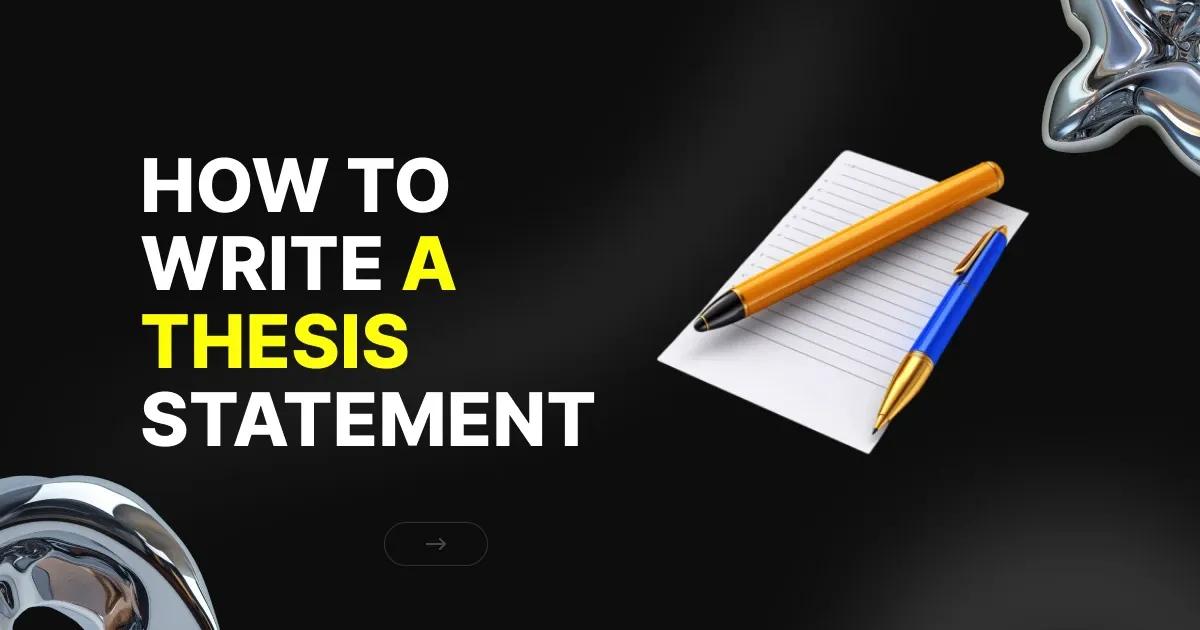Embarking on the journey of crafting a compelling essay begins with understanding the foundational elements of a thesis statement and essay outline. These components serve as the backbone of your academic or creative endeavors, providing structure and clarity to your thoughts and arguments.
In this comprehensive guide, we will delve into the intricacies of writing a robust thesis statement and a well-organized essay outline. Through a step-by-step exploration, you'll gain insights into the significance of each element and learn practical techniques to enhance your writing prowess.
Understanding the Purpose of a Thesis Statement
Defining the Thesis Statement
At its core, a thesis statement encapsulates the central idea or argument of your essay in a concise and declarative manner. It serves as the focal point around which your entire piece revolves, offering readers a clear understanding of what to expect.
A well-crafted thesis statement not only conveys your main point but also sets the stage for the subsequent discussion.
Importance of a Strong Thesis Statement
The significance of a strong thesis statement cannot be overstated. It not only provides direction to your writing but also helps you stay focused on your primary objective. A robust thesis statement guides readers through your essay, ensuring coherence and relevance in every paragraph.
Moreover, it establishes your credibility as a writer and demonstrates your ability to articulate complex ideas effectively.
Role in Guiding the Essay's Direction
One of the most crucial functions of a thesis statement is to guide the trajectory of your essay. By clearly stating your main argument or position, it helps you structure your thoughts and organize your supporting evidence.
Furthermore, a well-defined thesis statement enables you to maintain a cohesive narrative, preventing your essay from veering off course. In essence, it acts as a roadmap that leads both you and your readers towards a coherent and logical conclusion.
Components of an Effective Thesis Statement
Clarity and Conciseness
A fundamental aspect of an effective thesis statement is clarity. It should convey your main idea in a straightforward and unambiguous manner, leaving no room for confusion or misinterpretation.
Additionally, brevity is key – a concise thesis statement succinctly captures the essence of your argument without unnecessary verbosity.
Specificity and Focus
A strong thesis statement is characterized by its specificity and focus. Rather than presenting a broad topic, it should narrow down the scope of your essay to a specific aspect or viewpoint. This level of precision not only makes your argument more compelling but also helps you avoid tangential discussions that detract from your main thesis.
Argumentative Nature
An effective thesis statement is inherently argumentative, presenting a clear position or perspective that can be debated or analyzed. It should not merely state a fact or summarize the topic but rather take a stance that prompts further exploration and discussion.
By articulating a strong and debatable claim, your thesis statement invites readers to engage with your ideas and consider alternative viewpoints.
Crafting Your Thesis Statement
Brainstorming Ideas and Concepts
The process of crafting a thesis statement often begins with brainstorming ideas and concepts related to your topic. This initial exploration allows you to identify key themes or arguments that you wish to explore further in your essay.
Whether through freewriting, mind mapping, or discussion with peers, brainstorming helps you generate diverse perspectives and refine your focus.
Narrowing Down Your Topic
Once you've generated a list of potential ideas, the next step is to narrow down your topic to a manageable scope. This involves selecting a specific aspect or angle that you find particularly compelling or relevant.
By narrowing the focus of your essay, you can delve deeper into your chosen subject matter and provide more nuanced analysis.
Formulating a Clear Assertion
With a narrowed-down topic in mind, you can now formulate a clear and concise assertion that encapsulates your main argument. Your thesis statement should make a definitive claim or proposition that you intend to support throughout your essay.
This assertion serves as the foundation upon which you build your arguments and present your evidence, guiding the direction of your writing.
Constructing an Essay Outline
Introduction: Setting the Stage
The introduction of your essay plays a crucial role in setting the stage for the rest of your paper. It should provide context for your topic, establish the relevance of your thesis statement, and engage readers' interest.
A well-crafted introduction captivates the audience's attention, outlines the scope of your essay, and previews the main arguments you will be presenting.
Body Paragraphs: Developing Arguments and Evidence
The body paragraphs of your essay serve as the backbone of your argument, where you develop and support your thesis statement through logical reasoning and evidence.
Each paragraph should focus on a single main idea or argument, supported by relevant examples, quotations, or data. By organizing your thoughts coherently and providing sufficient evidence, you can persuade readers of the validity of your thesis.
Conclusion: Summarizing Your Points
In the conclusion of your essay, you reiterate the significance of your thesis statement and summarize the key points you've made throughout your paper. This is your final opportunity to leave a lasting impression on your readers and drive home the relevance of your argument.
A well-crafted conclusion ties together the various threads of your essay, reinforces your main thesis, and leaves readers with a sense of closure.
Tips for Writing a Cohesive Essay Outline
Organizing Your Thoughts and Ideas
Before diving into the writing process, take the time to organize your thoughts and ideas effectively. This may involve creating an outline, mind map, or list of key points that you intend to cover in your essay.
By establishing a clear structure from the outset, you can ensure that your writing flows logically and coherently from start to finish.
Establishing Logical Flow
In addition to organizing your ideas, it's essential to establish a logical flow between your paragraphs and sections. Each point should build upon the previous one, leading readers through a coherent and cohesive argument.
Transition sentences and cohesive devices such as pronouns, conjunctions, and transitional phrases can help maintain the flow of your writing and guide readers through your essay.
Maintaining Consistency Throughout
Consistency is key to crafting a cohesive essay outline. This involves maintaining consistency in tone, style, and formatting throughout your paper. By adhering to a consistent writing style and structure, you can create a seamless reading experience for your audience and reinforce the coherence of your argument.
Incorporating Copychecker into Your Writing Process
Overview of Copychecker's Features
Copychecker is a versatile grammar checker tool that offers a comprehensive suite of features designed to improve the quality of your writing. From grammar and spell checking to style analysis and plagiarism detection, Copychecker provides writers with the tools they need to polish their prose and elevate their writing to the next level.
With its user-friendly interface and intuitive design, Copychecker makes it easy to identify and correct errors, ensuring that your writing is clear, concise, and professional.
How to Integrate Copychecker into Your Workflow
Integrating Copychecker into your writing process is simple and straightforward. Whether you're writing a blog post, an academic paper, or a business report, Copychecker can help you streamline your proofreading and editing process. Simply copy and paste your text into Copychecker's online interface or upload your document directly from your computer.
Within seconds, Copychecker will analyze your writing for grammatical errors, punctuation mistakes, and other issues, providing you with detailed feedback and suggestions for improvement.
Leveraging Copychecker for Grammar and Style Corrections
Copychecker is not just a grammar checker tool – it's a comprehensive writing assistant that can help you improve every aspect of your writing. In addition to identifying and correcting grammatical errors, Copychecker offers style suggestions, readability analysis, and plagiarism detection, allowing you to fine-tune your writing for maximum impact.
Whether you're struggling with awkward phrasing, repetitive language, or unclear syntax, Copychecker can help you polish your prose and communicate your ideas more effectively.
Maximizing the Effectiveness of Grammar Checker Tools
Understanding Common Grammar Errors
To maximize the effectiveness of grammar checker tools, it's essential to understand common grammar errors and how to avoid them. Some of the most frequent mistakes include subject-verb agreement errors, comma splices, dangling modifiers, and misplaced apostrophes.
By familiarizing yourself with these common pitfalls, you can proactively identify and correct errors in your writing, improving its clarity and professionalism.
Utilizing Grammar Checker Suggestions Wisely
While grammar checker tools can be invaluable resources for writers, it's important to use their suggestions wisely. Not all suggestions will be applicable to your specific writing context, and blindly accepting every correction can sometimes result in awkward or unnatural phrasing.
Instead, carefully review each suggestion and consider whether it improves the clarity and coherence of your writing. Ultimately, you are the final arbiter of your own writing, and it's essential to trust your instincts and judgment when making revisions.
Manual Proofreading and Revision Techniques
In addition to using grammar checker tools, manual proofreading and revision techniques are essential for polishing your writing to perfection. Take the time to read through your essay carefully, paying attention to grammar, punctuation, spelling, and style.
Consider reading your essay aloud or asking a friend or colleague to review it for you, as fresh eyes can often catch errors that you might overlook. Finally, be prepared to revise and edit your writing multiple times, refining your arguments and polishing your prose until it shines.
Finalizing Your Thesis Statement and Essay Outline
Reviewing and Refining Your Thesis Statement
Before finalizing your thesis statement, take the time to review and refine it to ensure that it accurately reflects the central argument of your essay. Consider whether your thesis statement is clear, concise, and specific, and whether it effectively captures the essence of your argument.
Additionally, solicit feedback from peers, instructors, or writing tutors to gain fresh perspectives on your thesis statement and identify areas for improvement.
Ensuring Coherence Between Thesis and Outline
As you finalize your essay outline, it's essential to ensure coherence between your thesis statement and the structure of your essay. Each section of your outline should align with and support your main argument, guiding readers through a logical progression of ideas.
If necessary, revise your outline to ensure that it effectively communicates the scope and direction of your essay, reinforcing the relevance of your thesis statement throughout.
Polishing Your Writing with Grammar Checker Tools
Finally, polish your writing to perfection by incorporating grammar checker tools into your proofreading and editing process. Use Copychecker or another trusted grammar checker to identify and correct any lingering errors in your writing, ensuring that your essay is clear, concise, and professional.
Additionally, consider revising your essay for style, tone, and coherence, refining your arguments and polishing your prose until it meets your standards of excellence.
FAQs
How to write a thesis statement?
Writing a thesis statement involves identifying the main idea or argument of your essay and articulating it clearly and concisely in a single sentence. Start by brainstorming ideas, narrowing down your topic, and formulating a clear assertion that captures the essence of your argument.
How to write a good thesis statement?
A good thesis statement is specific, focused, and argumentative. It should make a clear and debatable claim that you can support with evidence throughout your essay. Take the time to refine your thesis statement, ensuring that it accurately reflects the scope and direction of your paper.
How to write a thesis statement example?
An example of a thesis statement might be: "The prevalence of social media has led to an increase in feelings of loneliness among young adults." This statement presents a specific argument (the impact of social media on loneliness) that can be explored and supported in an essay.
How to write a thesis statement for a research paper?
When writing a thesis statement for a research paper, consider the main question or problem you are addressing in your study. Your thesis statement should provide a concise answer to this question or propose a solution to the problem, guiding the direction of your research and analysis.
What is a thesis statement?
A thesis statement is a concise declaration that summarizes the main argument or point of your essay. It serves as the focal point around which your entire paper revolves, providing clarity and direction to your writing.
Enhancing Your Writing with a Strong Thesis Statement and Essay Outline
In conclusion, mastering the art of writing a compelling thesis statement and a well-organized essay outline is essential for academic success and effective communication. By understanding the purpose of a thesis statement, mastering the components of an effective thesis statement, and crafting a cohesive essay outline, you can elevate your writing to new heights.
Additionally, by utilizing grammar checker tools effectively and incorporating Copychecker into your writing process, you can polish your prose and ensure that your writing is clear, concise, and professional.




